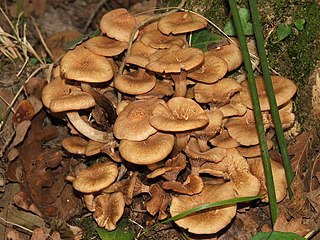
Armillaria is a genus of fungi that includes the A. mellea species known as honey fungi that live on trees and woody shrubs. It includes about 10 species formerly categorized summarily as A. mellea. Armillarias are long-lived and form the largest living fungi in the world. The largest known organism covers more than 3.4 square miles (8.8 km2) in Oregon's Malheur National Forest and is estimated to be 2,500 years old. Some species of Armillaria display bioluminescence, resulting in foxfire.

Armillaria mellea, commonly known as honey fungus, is an edible basidiomycete fungus in the genus Armillaria. It is a plant pathogen and part of a cryptic species complex of closely related and morphologically similar species. It causes Armillaria root rot in many plant species and produces mushrooms around the base of trees it has infected. The symptoms of infection appear in the crowns of infected trees as discoloured foliage, reduced growth, dieback of the branches and death. The mushrooms are edible but some people may be intolerant to them. This species is capable of producing light via bioluminescence in its mycelium.

Armillaria luteobubalina, commonly known as the Australian honey fungus, is a species of mushroom in the family Physalacriaceae. Widely distributed in southern Australia, the fungus is responsible for a disease known as Armillaria root rot, a primary cause of Eucalyptus tree death and forest dieback. It is the most pathogenic and widespread of the six Armillaria species found in Australia. The fungus has also been collected in Argentina and Chile. Fruit bodies have cream- to tan-coloured caps that grow up to 10 cm (4 in) in diameter and stems that measure up to 20 cm (8 in) long by 1.5 cm (1 in) thick. The fruit bodies, which appear at the base of infected trees and other woody plants in autumn (March–April), are edible, but require cooking to remove the bitter taste. The fungus is dispersed through spores produced on gills on the underside of the caps, and also by growing vegetatively through the root systems of host trees. The ability of the fungus to spread vegetatively is facilitated by an aerating system that allows it to efficiently diffuse oxygen through rhizomorphs—rootlike structures made of dense masses of hyphae.

Armillaria tabescens is a species of fungus in the family Physalacriaceae. It is a plant pathogen. The mycelium of the fungus is bioluminescent.

Armillaria gallica is a species of honey mushroom in the family Physalacriaceae of the order Agaricales. The species is a common and ecologically important wood-decay fungus that can live as a saprobe, or as an opportunistic parasite in weakened tree hosts to cause root or butt rot. It is found in temperate regions of Asia, North America, and Europe. The species forms fruit bodies singly or in groups in soil or rotting wood. The fungus has been inadvertently introduced to South Africa. Armillaria gallica has had a confusing taxonomy, due in part to historical difficulties encountered in distinguishing between similar Armillaria species. The fungus received international attention in the early 1990s when an individual colony living in a Michigan forest was reported to cover an area of 15 hectares, weigh at least 9.5 tonnes, and be 1,500 years old. This individual is popularly known as the "humongous fungus", and is a tourist attraction and inspiration for an annual mushroom-themed festival in Crystal Falls. Recent studies have revised the fungus's age to 2,500 years and its size to about 400 tonnes, four times the original estimate.
Armillaria apalosclerus is a species of mushroom in the family Physalacriaceae. This species is found in Asia.
Armillaria affinis is a species of agaric fungus in the family Physalacriaceae. This species is found in Central America.
Armillaria fellea is a species of mushroom in the family Physalacriaceae. This species is found in Australia.
Armillaria fumosa is a species of mushroom in the family Physalacriaceae. This species is found in Australia.
Armillaria griseomellea is a species of mushroom in the family Physalacriaceae. This species is found in South America.
Armillaria melleorubens is a species of mushroom in the family Physalacriaceae. This species is found in Central America.
Armillaria montagnei is a species of agaric fungus in the family Physalacriaceae. This species is found in Australia, Europe, New Zealand, and South America.
Armillaria omnituens is a species of mushroom in the family Physalacriaceae. This species is found in Asia.
Armillaria pallidula is a species of mushroom in the family Physalacriaceae. This species is found in Australia.
Armillaria tigrensis is a species of mushroom in the family Physalacriaceae. This species is found in South America.
Armillaria viridiflava is a species of agaric fungus in the family Physalacriaceae. This species is found in South America.
Roy Watling, PhD., DSc, FRSE, F.I.Biol., C.Biol., FLS is a Scottish mycologist who has made significant contributions to the study of fungi both in the identification of new species and correct taxonomic placement, as well as in fungal ecology.

Rhizomorpha is a genus of fungi that was created for species known only by their mycelial cords ("rhizomorphs") and so impossible to classify within the normal taxonomic system, which is based on reproductive structures.




